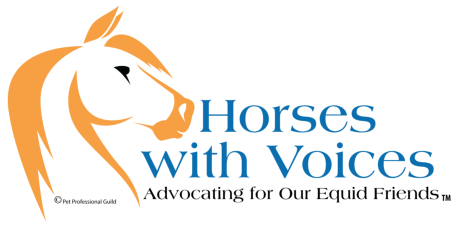Why Horses With Voices!
Equids are cognitive, intelligent creatures that experience emotions such as fear, anxiety, and joy.
All animals are subject to the same laws of applied behavior analysis (ABA.) While tactile cues and safety equipment are a realistic necessity of caring for and training animals, any stimulus not paired with a positive stimulus is, at best, neutral and, at worst, frightening and/or painful to the animal.
Animals who learn to exhibit behaviors to escape or avoid fear or pain have by definition been subjected to an aversive stimulus. Avoidance learning is very real, and the threat of pain is just as capable of inducing stress, fear and emotional damage as the pain itself.
If you know better – please do better!
HORSES WITH VOICES INTRODUCTION
“THE HORSE. HERE IS NOBILITY WITHOUT CONCEIT, FRIENDSHIP WITHOUT ENVY, BEAUTY WITHOUT VANITY. A WILLING SERVANT, YET NEVER A SLAVE.”—RONALD DUNCAN
Horses with Voices is a movement, a paradigm shift within the equid world, empowering equids by giving them a voice in their care and training; empowering equid enthusiasts worldwide to adopt more equid-considerate approaches in caring for their equids; and empowering every equid guardian to embrace the science of equid emotion, learning, and behavior.
Why do we need to give horses and their equid friends a voice? Because the science of equid behavior and training continues to evolve. We have a broader understanding of the species-specific needs of our equids—needs that often remain unmet with current stabling and training practices. We have a growing body of knowledge proving that horses trained utilizing positive reinforcement learn faster, learn more complex skills, and are safer to work with than their counterparts trained using forceful methods.
By giving voice to equids—and the people who work with them—we open a door to the complex, rich emotional worlds our equids live within. We give them better lives.
Join us in pledging, committing, to the key principles which truly give our equid friends a voice in their care and training.
Downloading Resources
PDF files:
Click on the pop-out icon ( ) in the top-right corner of the resource to open it in Google Drive. Click the download icon ( ) in the upper right-hand corner of the Google Drive page to save the resource to your computer.
Images and graphics:
Right click on the image or graphic then choose "Save image as ..." from the drop-down menu to save the resource to your computer.
Videos:
Click on in the video's menu bar to download and share the video from the Vimeo website.

